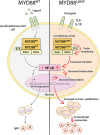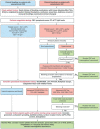Bleeding Propensity in Waldenström Macroglobulinemia: Potential Causes and Evaluation
- PMID: 35817084
- PMCID: PMC9626029
- DOI: 10.1055/a-1896-7092
Bleeding Propensity in Waldenström Macroglobulinemia: Potential Causes and Evaluation
Abstract
Waldenström macroglobulinemia (WM) is a rare, incurable, low-grade, B cell lymphoma. Symptomatic disease commonly results from marrow or organ infiltration and hyperviscosity secondary to immunoglobulin M paraprotein, manifesting as anemia, bleeding and neurological symptoms among others. The causes of the bleeding phenotype in WM are complex and involve several intersecting mechanisms. Evidence of defects in platelet function is lacking in the literature, but factors impacting platelet function and coagulation pathways such as acquired von Willebrand factor syndrome, hyperviscosity, abnormal hematopoiesis, cryoglobulinemia and amyloidosis may contribute to bleeding. Understanding the pathophysiological mechanisms behind bleeding is important, as common WM therapies, including chemo-immunotherapy and Bruton's tyrosine kinase inhibitors, carry attendant bleeding risks. Furthermore, due to the relatively indolent nature of this lymphoma, most patients diagnosed with WM are often older and have one or more comorbidities, requiring treatment with anticoagulant or antiplatelet drugs. It is thus important to understand the origin of the WM bleeding phenotype, to better stratify patients according to their bleeding risk, and enhance confidence in clinical decisions regarding treatment management. In this review, we detail the evidence for various contributing factors to the bleeding phenotype in WM and focus on current and emerging diagnostic tools that will aid evaluation and management of bleeding in these patients.
The Author(s). This is an open access article published by Thieme under the terms of the Creative Commons Attribution-NonDerivative-NonCommercial License, permitting copying and reproduction so long as the original work is given appropriate credit. Contents may not be used for commercial purposes, or adapted, remixed, transformed or built upon. (https://creativecommons.org/licenses/by-nc-nd/4.0/).
Conflict of interest statement
None declared.
Figures




References
-
- Talaulikar D, Tam C S, Joshua D. Treatment of patients with Waldenström macroglobulinaemia: clinical practice guidelines from the Myeloma Foundation of Australia Medical and Scientific Advisory Group. Intern Med J. 2017;47(01):35–49. - PubMed
-
- Spanish Group for the Study of Waldenström Macroglobulinaemia and PETHEMA (Programme for the Study and Treatment of Haematological Malignancies) . García-Sanz R, Montoto S, Torrequebrada A. Waldenström macroglobulinaemia: presenting features and outcome in a series with 217 cases. Br J Haematol. 2001;115(03):575–582. - PubMed
-
- Treon S P. How I treat Waldenström macroglobulinemia. Blood. 2015;126(06):721–732. - PubMed

